Published September 26, 2018
As the days get shorter and the weather gets colder, Ontario begins to paint itself with brilliant hues of red, yellow, and orange. It’s the perfect time of year to be outside. The humidity drops. Skies turn deep blue, dotted by white puffball clouds.
Sure, you can take a stroll through your local park or hit a 400-series highway in search of vibrant, photo-worthy foliage. But why leave things up to chance?
Ontario is home to some of the best fall forests in the world. Our guide will teach you everything you need to know to get the most out of Ontario’s beautiful season.
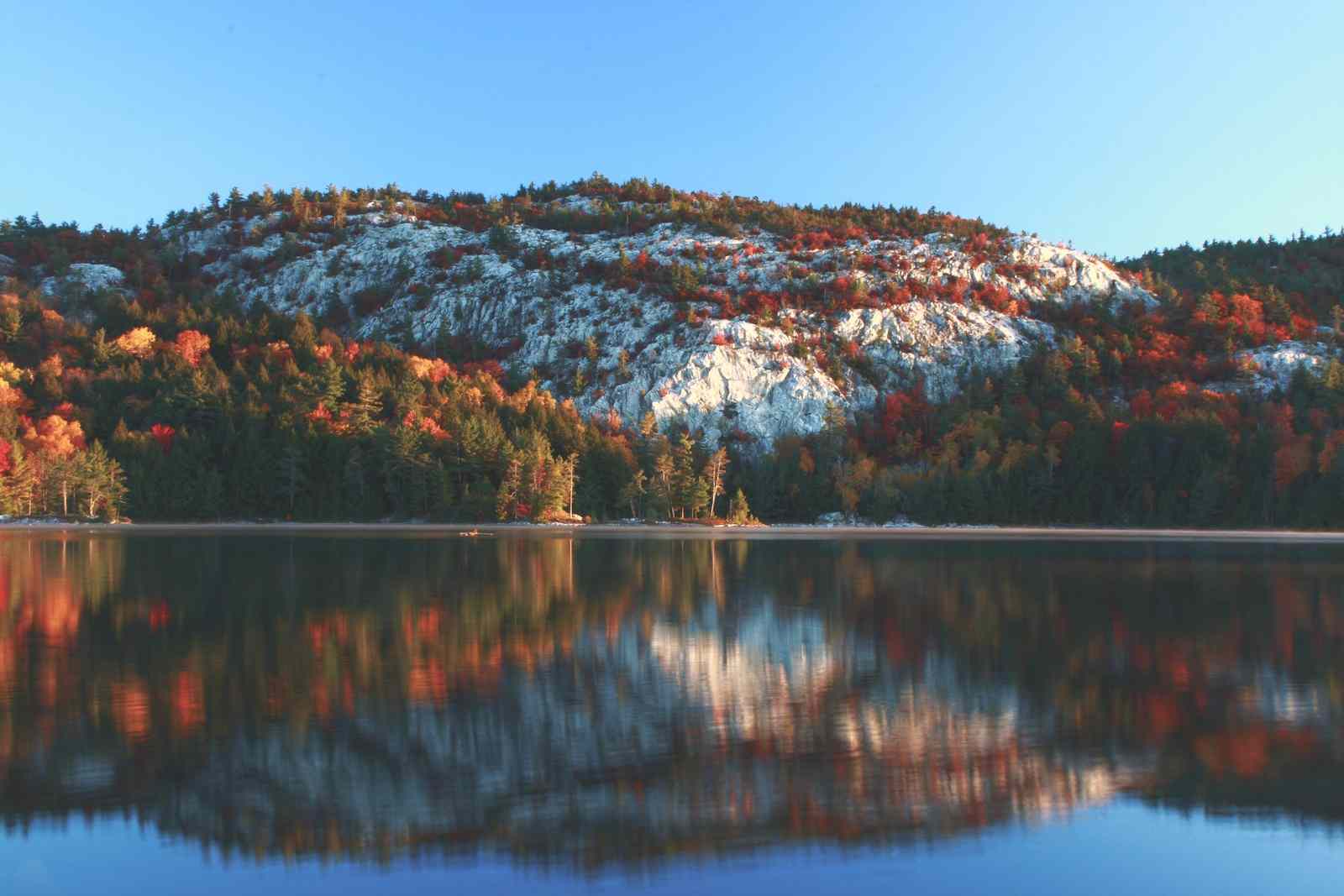
There are good trees and bad trees (when you want to see fall colours)
Deciduous trees have broad leaves that change colour and fall off in autumn. Those are the ones that you want to seek out in the fall.
Coniferous trees (cone-bearing) are the ones most people call “evergreens”. They have needles (instead of flat leaves) that stay on the branches all year long. Those are the best trees to see on a snowy winter walk. Save them for next season.
Trees grow because of the Great Lakes
For thousands of years, glaciers formed, moved, melted, and scoured the land that we now call Ontario. This historic carving of the land is good news for you! The resulting land formations make for the ultimate fall hike, bringing you to a hill, rocky lookout, or open shoreline area where you can see the beautiful forest colours with an unobstructed view.

Most importantly, the glaciers left behind rich soils that support all kinds of tree life. As you travel from southern to northern Ontario, the ground changes. These varied landscapes gives rise to Ontario’s different forest regions.
It takes many trees to make a forest
With more than 200 types of trees growing in Toronto alone, learning the names of Ontario’s trees can seem a bit overwhelming. Luckily, you don’t need to know every single tree type to enjoy a walk in the woods.
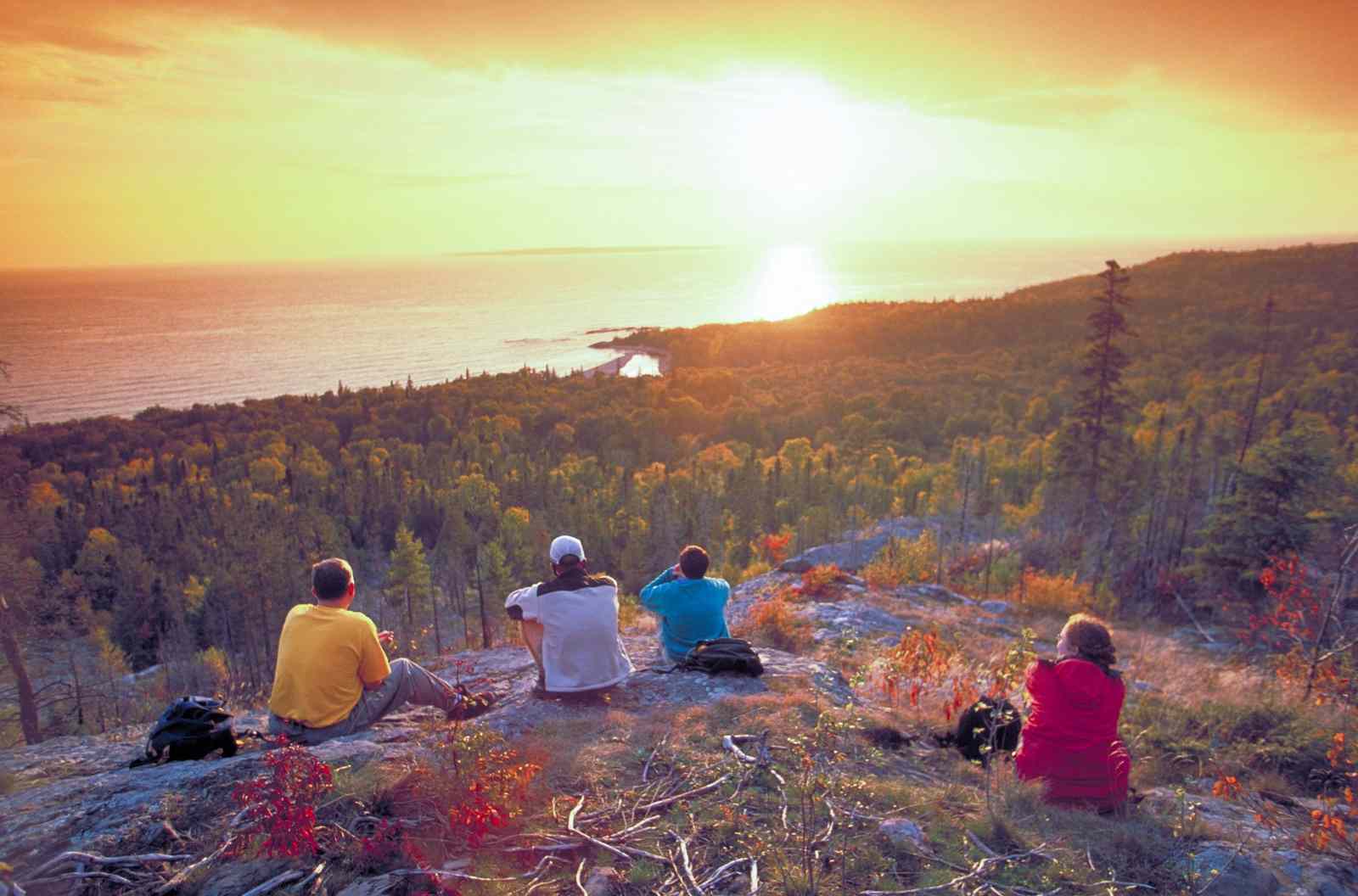
There are four forest regions in Ontario: The Hudson Bay Lowlands, the Boreal Forest, the Great Lakes-St. Lawrence Forest, and the Deciduous Forest (sometimes called the Carolinian forest).
Each region has a set of unique characteristics and tree species. With the exception of the northern Hudson Bay Lowlands, these regions also fall within the Great Lakes watershed. All of the rain and snow that falls on these forest regions eventually makes its way to the Great Lakes or the St. Lawrence River.
The more you know about the different types of forest regions, the more you can predict what colours, animals, birds, and vistas you’ll encounter on your adventure.
The many colours of the Great Lakes-St. Lawrence Forest
The Great Lakes-St. Lawrence Forest region is the second largest in the province and reaches into some of the most populated areas of Ontario. It is the one that we typically associate with classic images of autumn hikes, leaf-peeping, and camping in Ontario.
This forest is dominated by deciduous trees — those broad-leafed trees that create vibrant multi-coloured autumn displays. Yellow Birch, Beech, and Basswood trees turn bright yellow. Sugar Maples and Red Oaks trees turn deep red. Enough evergreens like White Pine, Red Pine, and Hemlock dot the forest to create a contrasting green backdrop.

Check out Algonquin Park for the classic Great Lakes - St. Lawrence Forest experience
To experience a kaleidoscope of colour, head out to the famous Algonquin Provincial park. Sugar Maples and Red maples (red/orange) dominate in Algonquin Park. The Sugar Maple is the iconic tree species in Canada, with its bright red leaf adorning the Canadian flag. Sugar Maples in Algonquin Park typically reach peak colour change around the 27th of September.

Algonquin leaves usually change colour earlier than other leaves in the area. This happens because Algonquin is higher — it sits at 600m above sea-level, compared to Toronto which sits at 75m above sea-level. Higher elevation means cooler temperatures, a shorter growing season, and earlier colour change.
The iconic yellow and green of the Boreal Forest
The Boreal Forest is the largest forest region in Ontario. It makes up a whopping two-thirds of the province’s forest. The Boreal Forest is mostly coniferous (cone-bearing, evergreen) trees. You’ll see Black Spruce, White Spruce, Jack Pine, Eastern White Cedar, and Balsam Fir here.
But don’t be fooled! This region also has its fair share of autumn colours.
The hero tree is the unique Tamarack. While they are conifers (cone-bearing), they are not evergreen trees. Their green needles turn yellow and fall off in autumn, with new needles growing in the spring. While the Tamarack tree is found all over Canada, it is abundant in Northern Ontario within the Boreal Forest. Tamarack’s brilliant yellow hues peak in late October.
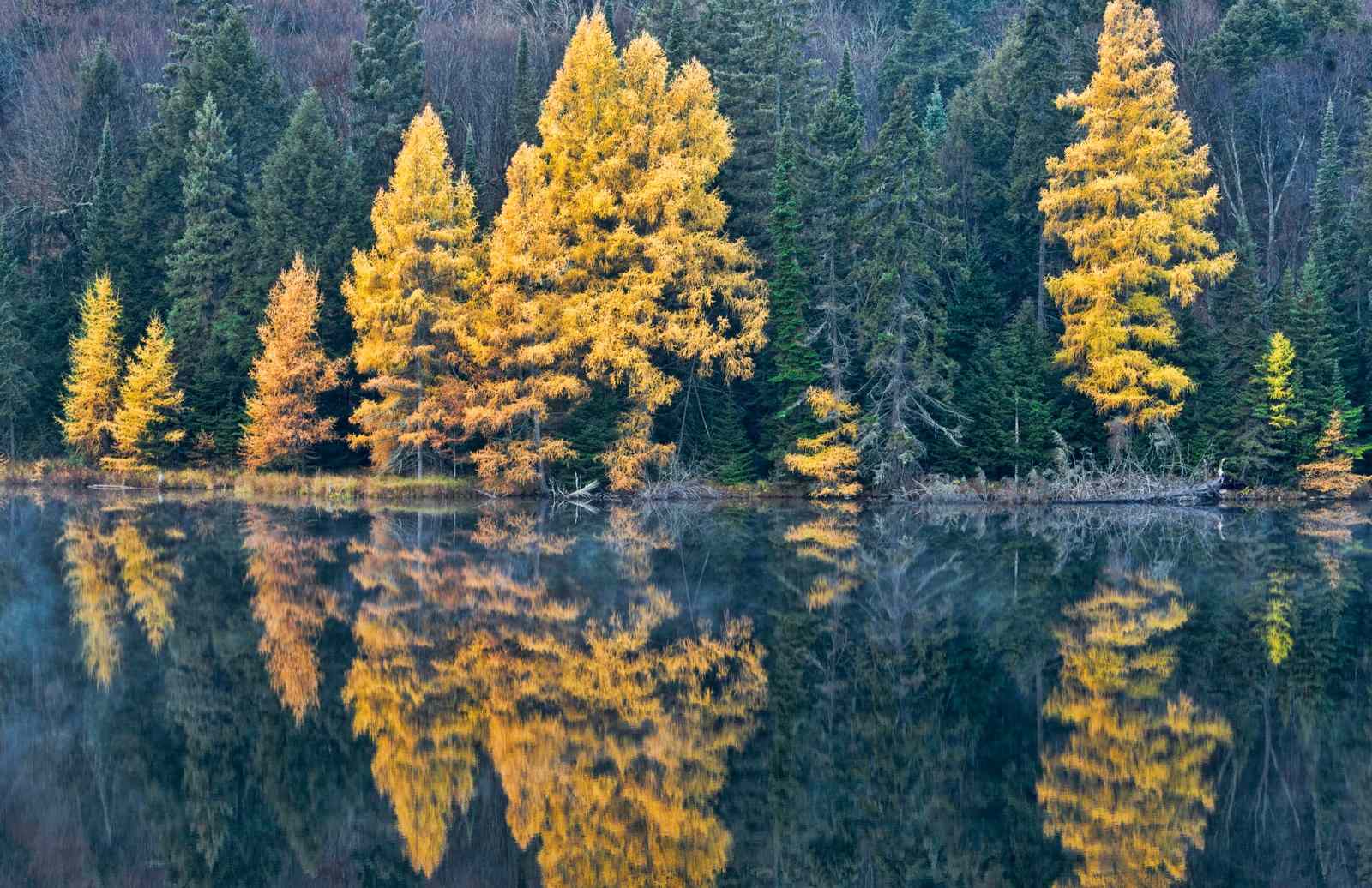
Other deciduous (broad-leaf) trees in this area also turn bright yellow in the fall. These trees include White Birch and Poplars (including Jack’s Hybrid Poplar and the Balsam Poplar). All of this yellow contrasts against the dark evergreens of the Boreal Forest to create a special fall colour show.

Check out Sleeping Giant Provincial Park for the unique Boreal Forest experience
To experience a northern Ontario yellow autumn, head out to Sleeping Giant Provincial Park. Tamaracks, Birches, and Poplars are abundant, thriving along the sunny, open cliff faces. Mid-October is the ideal time to head out for a hike through the park. You will be treated to glorious bursts of colour as you make your way to the top of the Sleeping Giant.
The precious Deciduous Forest close to home
The Deciduous Forest region is the smallest and most southern forest region in Ontario. It runs along the north shore of Lake Erie and Lake Ontario, where most people in the province also live.
Commonly called the Carolinian Forest in Ontario, this is where you will find the most diverse array of tree species. With its diversity of wildlife and proximity to many cities and towns, the Carolinian Forest should be the easiest and most rewarding place to bathe in the autumn forest colours.
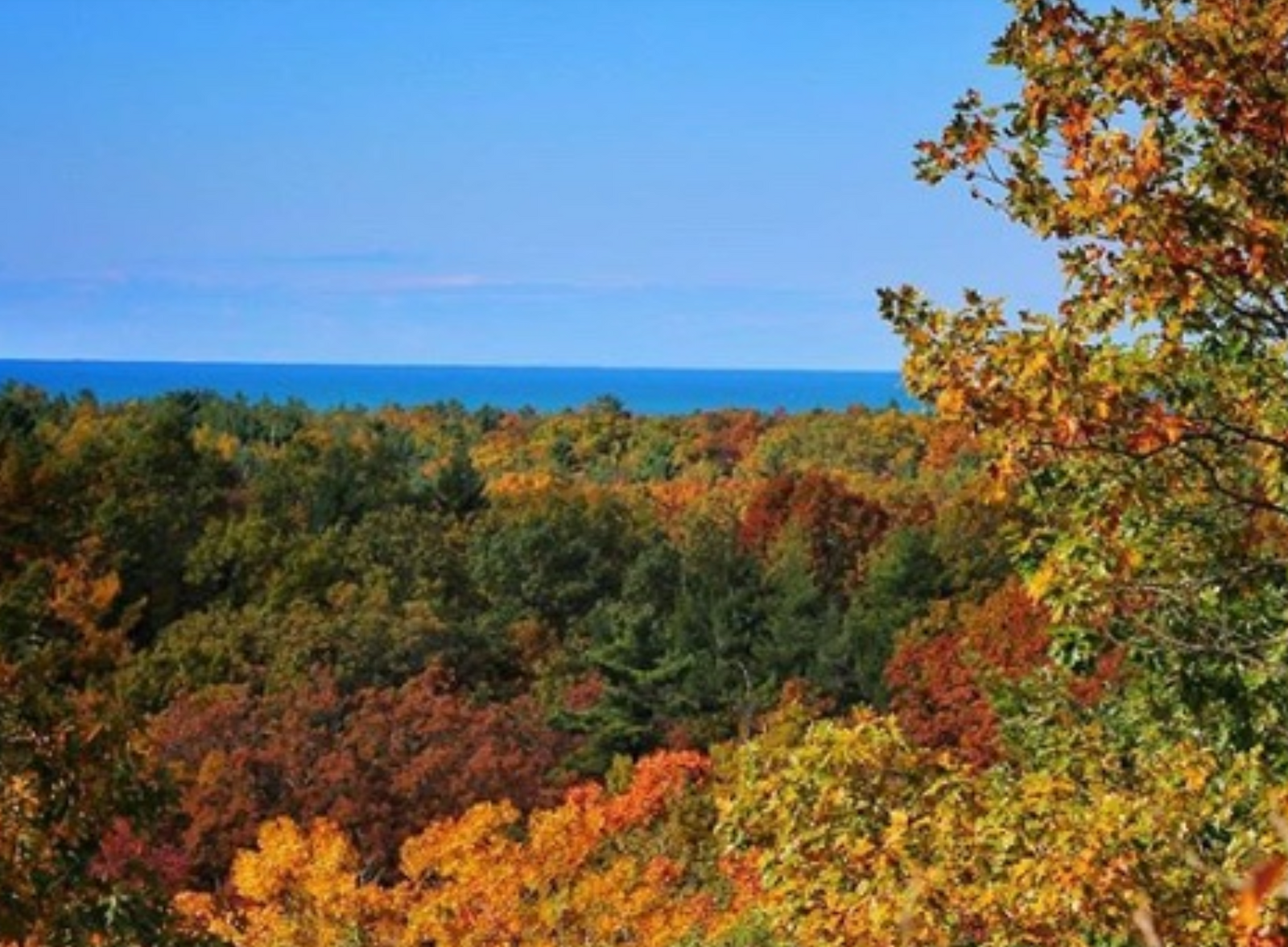
Sadly, human development has had a huge impact in this forest region. Since the beginning of colonization, 90% of this forest has been cut down to make way for urban development and farming. What you see when you visit these forests is only a tiny fraction of the original forests that once grew here.
Carolinian Forests are home to Maple, Oak, and Sumac trees, with their famous bright red hues. Ash and Sassafras trees explode in vibrant oranges, while the brilliant yellows of Birch, Walnut, Hickory, and Chestnut trees shine in autumn sunlight. There are enough evergreens — like Hemlock and Cedar — to give you a pop of green. In peak season, you can expect to see a rainbow of colours.

Check out Pinery Provincial Park for an accessible, stunning Carolinian Forest experience
To experience this leaf-based rainbow, head out to the Pinery Provincial Park. Mid- to early-October is the ideal time to visit, with the leaves painting the landscape in full colour. Hike the ten hiking trails or along the rolling sand dunes for unmatched views of Ontario’s unique autumns.
Make sure you stay into the evening to watch as the sun sets over the trees. Sunsets here were declared one of the top ten best in the world by National Geographic.
Knowing why leaves change colour can help you plan better
As you head towards your forest of choice, you may find yourself wondering why the colours change at all.
Why does this part of the planet experience such a vibrant autumn?
Well, Ontario just happens to be situated in an ideal geographic location. Late in the year, we have fewer hours of sunlight. Days are shorter and less sun reaches the trees.
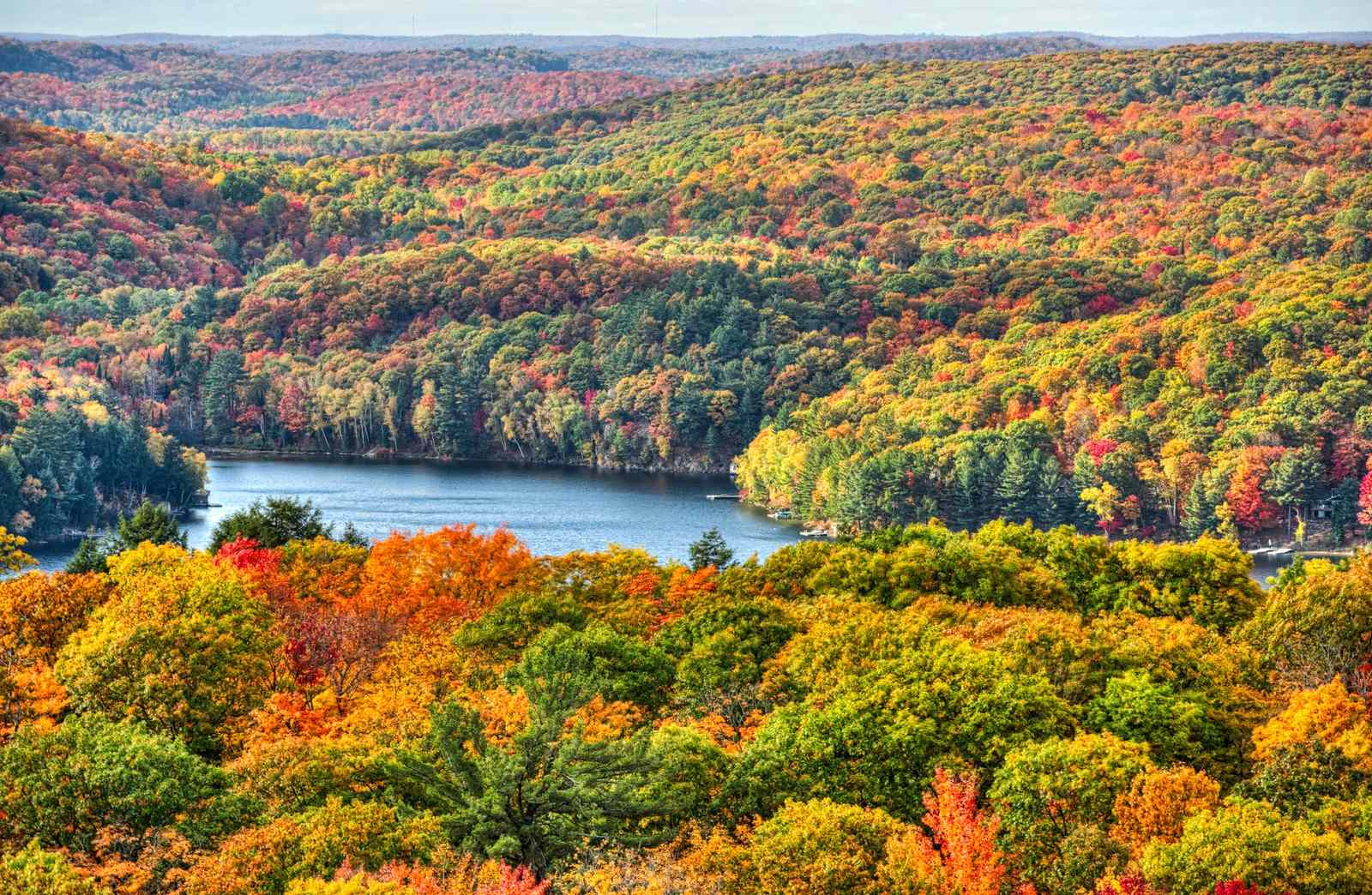
How do the leaves actually change colour?
It all comes down to energy. Just like people, trees need food to survive. Most leaves on trees are naturally green because they have a chemical in them called chlorophyll. Chlorophyll captures the sun’s energy, transforming it into sugar (food for the tree). And guess what: chlorophyll is green!
In the spring and summer, green chlorophyll outnumbers any other pigment. This is why we see green leaves.
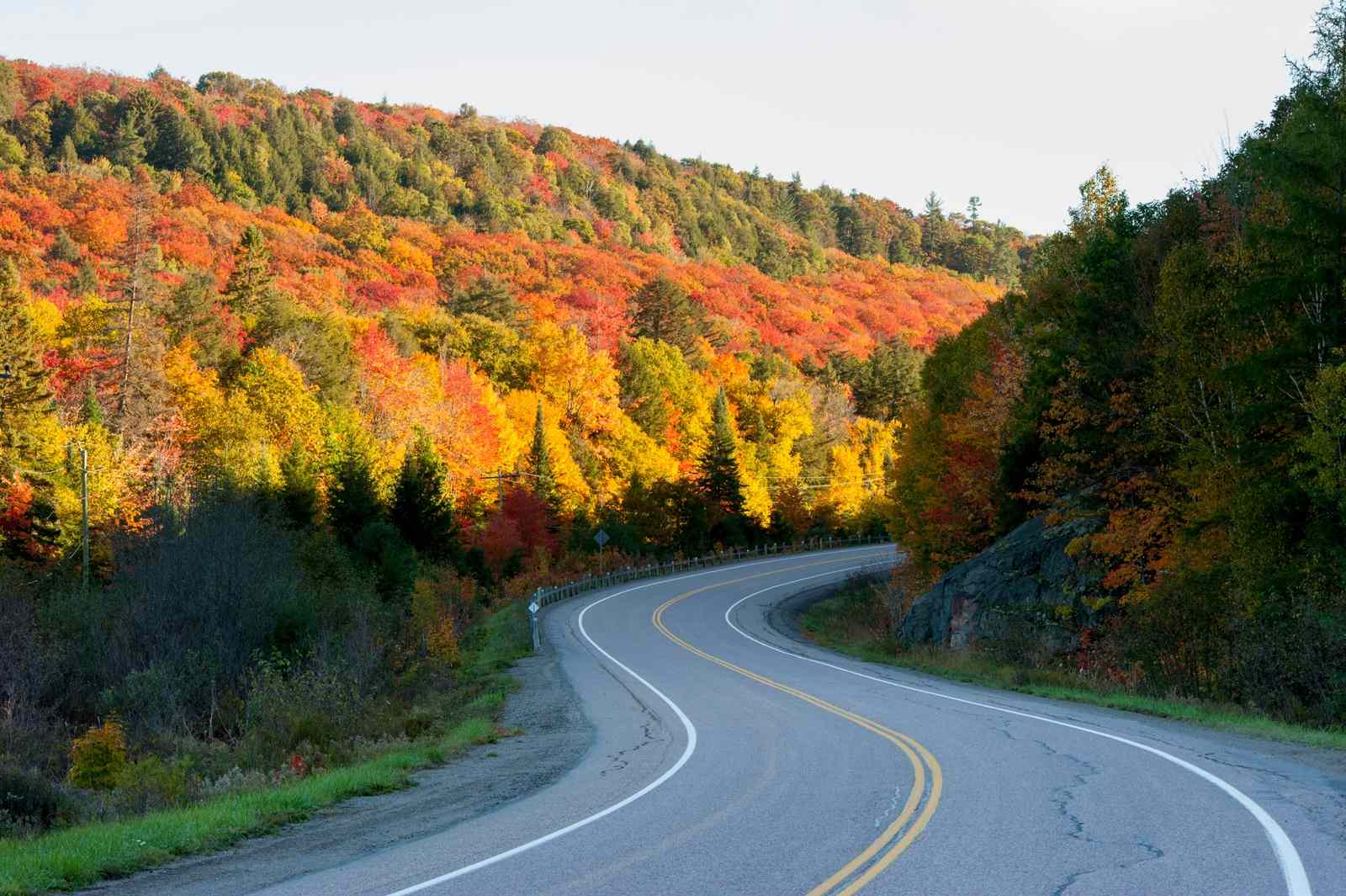
As the days get shorter and the weather cools down, the trees see far less sun. This causes the trees to make less chlorophyll. That’s when orange, red, yellow, and purple pigments shine through. We see more of the bright red, orange, and yellow colours in autumn, but they were there all along.
The rainbow colours of fall don’t last long. They start first where the weather is cooler, in the northern parts of Ontario and in areas with higher elevation. Peak season may only be 1-2 weeks long. Then the leaves start to turn brown and fall to the ground.
Get there before the leaves fall off
Once the leaves start to change, you need to act fast. A few cold nights or rainy days can bring an end to the beautiful days of fall.
The leaves no longer have enough chlorophyll to make energy, so they don’t serve a purpose for the tree. Their stored energy is sucked into the trunk of the tree. It is stored there and then used up slowly during the winter months.

Once a tree has moved all its energy into the trunk, branches, and twigs, the leaves fall off . When spring hits, the tree blooms new leaves to capture the sunlight and create more energy for the coming year.
The perfect conditions for a bright, colourful autumn are sunny days, dry weather, and cool (but not freezing) nights. A harsh frost could cause the leaves to drop off right away, skipping those weeks of brilliant hues. Cold nights can also quicken the process of leaves changing colour, because cold temperatures destroy the green chlorophyll.

No matter where you choose to explore in Ontario in the fall, you may be greeted with dazzling views. The brighter the sun and drier the fall, the better those views will be. A few hours in the forest can leave you feeling energized and connected to the Great Lakes region. You may even be left wishing that autumn would come more than once a year.
You can also look for these trees in your neighbourhood.
